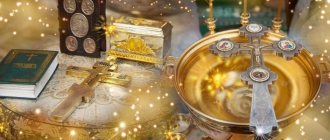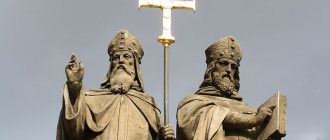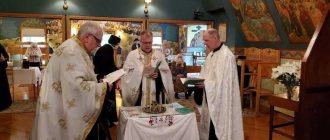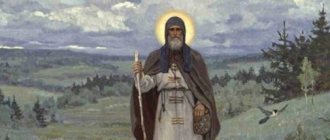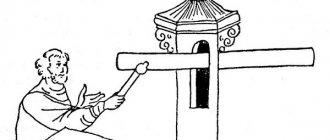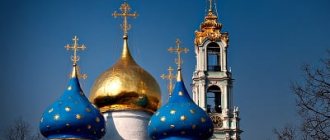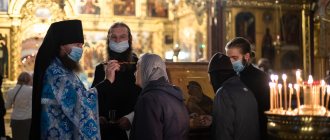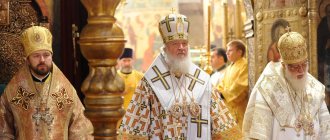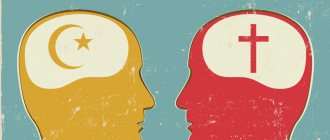Story
According to the four Gospels, the Resurrection of Jesus Christ occurred on the Jewish holiday of Passover. On this day, the Jews celebrated the exodus from Egypt. The Old Testament says that the last “Egyptian execution”, which finally persuaded Pharaoh to decide to release the Jews, was the killing of all the firstborn by an angel. The angel did not touch only those who slain the lamb and smeared its blood on their doors. Thus, the blood of the lamb saved people from death. In the New Testament, Christ played the role of the Lamb who saves people.
Title "Easter"
Gradually, the Hebrew word “Pesach” was transformed into the Russian “Easter”. And people began to use the abbreviated name of the holiday more often instead of the full name.
The first Christians believed that they were living at the end of time and expected the Second Coming every year. In memory of the sacrifice of Jesus, they began to celebrate the liturgy, remembering all the events - from the Last Supper to the Resurrection. Every Friday turned into a day of mourning, and Sunday into a day of joy. This bitterness and joy reached their climax on the day of Jewish Passover. This is how Easter was born in our modern understanding.
What holidays are there in Christianity?
Speaking in very general terms, Holidays in the Orthodox Church can be divided into the following “categories”:
- Easter
(Resurrection of Christ) is the main holiday. - The Twelfth Feasts
are 12 holidays that commemorate the main events in the life of the Blessed Virgin Mary and Jesus Christ. Some of them are reflected in the texts of the New Testament (the Gospel or the Acts of the Apostles), and some (the Nativity of the Mother of God, the Entry into the Temple of the Blessed Virgin Mary, the Exaltation of the Cross of the Lord) are taken from Church Tradition. Most of them have a specific date of celebration, but some depend on the date of Easter. We tell you more about each Twelfth holiday below. - Five Great Non-Twelfth Holidays
. Circumcision of the Lord and the memory of St. Basil the Great; Christmas of St. John the Baptist; Memory of the Apostles Peter and Paul, the Beheading of John the Baptist and the Protection of the Most Holy Theotokos. - Any Sunday day of the year
is a direct reminder of the Resurrection of Christ. - Middle Holidays
: Days of remembrance of each of the Twelve Apostles; Finding the honest head of John the Baptist; Days of remembrance of Saints John Chrysostom and Nicholas the Wonderworker, as well as the 40 Martyrs of Sebaste. Memory of the Vladimir and Kazan icons of the Mother of God. In addition, the average holiday for each temple is its Patronal Feast. That is, the memory of the saints in whose honor the altar or altars are consecrated, if there are several of them in the temple. - Small Holidays
: all other days.
Easter in Rus'
The holiday came to our region along with Christianity. After Saint Prince Vladimir baptized Rus', Easter became the most important state event. Celebrations have since lasted for at least three days. Sometimes Russian princes, after successful campaigns or the birth of an heir, extended the celebration for a whole week.
Resurrection Day preceded Lent, which lasted at least forty days. Our ancestors used this period of time for spiritual cleansing. Pilgrimage to monasteries was very popular. Simple peasants set out on foot many kilometers to arrive at the monastery during Lent. There they confessed and celebrated Easter already cleansed.
Celebrations in modern times
At all times, right up to the end of the first quarter of the 20th century, Easter remained not only the main spring holiday, but also the most central event in the calendar. This was the case until the early twenties, when atheism became government policy. The authorities banned Easter liturgies, contrasting the Resurrection of Christ with its counterpart - Workers' Solidarity Day.
But already in the early nineties of the last century, all prohibitions were lifted and several red days in the spring again appeared on the calendar. As in the old days, Easter occupies a dominant place among all religious events. Even the head of state attends a service on this day in the Cathedral of Christ the Savior in Moscow.
Children about Orthodox holidays
Orthodox holidays
Goals: - expand the horizons of students; - stimulate interest in Orthodox traditions and rituals; — to cultivate such qualities in children as kindness, humility, mercy, patience. Equipment: thematic material, visual aids - pictures, calendars, rosary, cross, books. Guys, today we will talk about a topic that is unusual for your everyday life: Orthodox holidays. You may think: “Why do we need this? It is not interesting". But not everything is as you think. If you look around, you will see that we are surrounded by objects of the Orthodox religion.
You, your friends, parents, grandparents wear crosses, which are given to you by your godparents at baptism. Do you have godparents? Do they talk to you about God, prayers, church? This is their responsibility. Godparents should not only rejoice at your successes, exclaim how you have grown lately, and give gifts for the holidays, but they should also develop your spirituality, talk to you about the life of Christ, and teach you goodness. Among other things you may notice Orthodox calendars. Have you noticed? Where did you see them? In addition to the main function, such a calendar contains information about fasts, events related to the lives of saints and more. Do you guys know what a post is? This, in simple words, is a period of time during which the consumption of certain types of foods is prohibited, entertainment and games are prohibited. Do you have a family library? So, among the books that are in it, you can find the Bible. Do you know what the Bible is? Icons hang in almost every home. Do you have icons at home? What do you think they are for? What is prayer? They pray to the icon, or rather to the saint who is depicted on the icon.
But it is best to pray in church.
It is believed that this is the house of God and prayers said here will be heard faster by the Lord God. Have you been to church? What did you notice there? You may have noticed a rosary on the priest's wrist. He needs them when reading prayers. Certain prayers should be read several times, so in order not to lose count, he sorts through the beads. We can give many more examples of such things: icons in cars, figurines in the form of angels, etc. But we decided that you would be bored hearing about Orthodoxy as such, so we will tell you about Orthodox holidays. After all, a holiday is a day of joy and celebration about something. For a long time in our country it was not customary to talk about these holidays, although they were celebrated in many homes. We are talking about religious holidays. Our country is large and multinational, and different religions coexist in its vastness. There are places where churches of different faiths coexist peacefully. And yet, the majority of the Russian population is Orthodox Christians, so we will focus on Orthodox holidays. Guys, what Orthodox holidays can you name? Religious holidays occupied an important place in the life of the people, and at all times the main holidays were timed to coincide with the cycles of nature, the beginning and end of field work. Festive rituals accompanied the onset of spring, the first plowing, and the harvest. And in the Orthodox church calendar one can find echoes of ancient landowning rituals. Every Christian holiday is associated with a biblical legend. Believers, participating in the holidays, seem to relive the great events of the life of Christ and his loved ones. The Russian Orthodox Church has many holidays, but among them the main ones stand out, called twelve (since there are twelve of them). The church year begins in the fall. Before Peter’s reforms, the civil year in Russia began in September. But, since now the calendar New Year falls on the first of January, we will start talking about Christian holidays with Christmas. CHRISTMAS AND HOLIDAY Christmas - January 1st Christmastide - January 7th to 19th Christmas week Creaky steps. Non-target targets Below the leg vector. Christmas frosts Quite heavenly style And the air is white and pink And sweet, Like vanilla...
CHRISTMAS is one of the most important Christian holidays. Christmas has recently “returned” to our lives. In the recent past, it was not even customary to mention it, but now it is one of the few public holidays, a non-working day. Guys, what do you know about Christmas?
Christmas has long been accompanied by colorful folk customs. Carols, walking with a star, dressing up. It is customary to invite your closest people to visit at Christmas, but this does not mean that friends and classmates cannot get together. It is important that everyone has a good time on this holiday, and no one should be bored alone. On this holiday it is customary to sing carols. Can you tell me what carols are? Do you know any carols? Carols are special songs with wishes for a rich harvest, health, and harmony in the family. Few people know these songs now. But why not congratulate at least the neighbors on the landing in a cheerful, playful manner?.. And for congratulations and jokes, they will treat you to cookies, gingerbread, and candies. In the old days, carolers sang: “If you give us gifts, we will reproach you!” Kolyada, Kolyada! Serve the pie!
Christmas Ditties Oh, yes, every winter My friend Zinushka and I,
Loaded with jokes, We go everywhere dressed up... We sing to our heart's content, we try, and don't repeat ourselves: All of them are carols, collected in a notebook.
Sergey Belorusets
They dressed up as old men bears, parsley devils - why not a modern masquerade? And if a “stunning” evening outfit was specially prepared for the New Year, why not dress up for Christmas in a simple costume with a mask and let yourself “relax” in a game and fun? After all, everything is available and permitted to mummers! Of course, within reasonable limits, so as not to offend the owners of the house or cause irreparable damage in the form of a broken vase or cup. From Christmas to Epiphany (January 19) the holiday season continues. At this time, it is customary to have fun and have fun, but wisely and usefully. Schoolchildren are on vacation, and during the day in the fresh air, you can organize a “Winter Fun” holiday. And there are a great many of these amusements, which came from distant times from our ancestors - the Slavs. There is sledding down the mountain - who's next, and speed skating competitions, and throwing snowballs - at a target and at a distance, and sledding trains for kids... In general, “the frost is not great, but it’s not good to stand” - let the guys compete in strength and dexterity, and then have tea with gingerbread and sweets. Or you can do it with cookies and buns, specially baked for Christmas in the shape of pigs, cows, lambs and sheep. And in the evening there are gatherings. This is also a long-standing tradition: in Russian villages, with the onset of winter, girls pooled together to rent a hut, where on long winter evenings they spun, embroidered, knitted and always sang. But Christmas gatherings are special. They didn’t take work for them, they came to relax and have fun. And most importantly, look at the bride and groom. Times have changed, but why not have a get-together - with songs. Dancing and games? If these traditional Christmas fun are not enough, there are also charades, quizzes, magic tricks, educational games and fortune telling.
Christmas customs from different countries BULGARIA
Here it is customary to pass from generation to generation an old silver coin, which at Christmas is baked into a special pie - pogača. Before cutting the pie, it is carefully inspected: bubbles on the surface mean family happiness. And the happiest this year will be the one who gets a piece of the pie with a coin.
POLAND
On Christmas Eve, in a house where the customs of antiquity are observed, unthreshed sheaves of bread are placed in all four corners, hay is placed under the tablecloth, and a special device is placed on the festive table - the memory of family members who have passed away forever. This evening no one should feel forgotten, so it is customary to invite single people to a family Christmas Eve.
HUNGARY
A traditional Christmas dish is garlic with honey. And on Christmas evenings, in front of a house where there is a girl of marriageable age, young men stage playful performances by mummers - the betrothed will decide who will receive the award with a kiss.
FRANCE
The cycle of French Christmas holidays includes the Day of St. Catherine, the patroness of girls. Previously, young trees were planted on this day, and the streets of cities and villages were filled with crowds of girls in elegant caps sewn with their own hands.
Winter quiz based on the book by V. Bianchi “/Tight Newspaper”
1. Where do crayfish spend the winter? 2. What is more scary for birds in winter - cold or hunger? 3. If the hares began to turn white late, what kind of winter should we expect - early or late? 4. What is Woodpecker Forge? 5. What nocturnal predator appears here only in winter? 6. What is a “bunny discount”? 7. Where do crows sleep in winter and autumn? 8. When do the last seagulls and ducks fly away from us? 9. What birds do woodpeckers keep company with in autumn and winter? 10. What do trackers call “dragging”? 11. Carrying arms, no legs - asking to go to the hut? 12.Two are shining, four are in bed, one is going to bed? 13. Born in water, but afraid of water? 14. Blacker than soot, whiter than snow, higher than a house, lower than grass? 15.Walks on the ground, doesn’t see the sky, doesn’t hurt anything, but still moans?
Epiphany January 19
Orthodox Christians celebrate this holiday on January 19. Epiphany is one of the two twelve holidays. It was installed in honor of the baptism of Jesus Christ in the waters of the sacred Jordan River. Are all of you baptized? It's never too late to get baptized. Jesus was baptized when he was 33 years old. On this day, the main thing is the blessing of water in the church and the ice hole (this ice hole, specially made for the blessing of water, is called Jordan). After prayer, believers wash themselves with holy water and take it with them, believing that this water has miraculous powers. And indeed, such water remains fresh for a very long time and does not spoil. By the way, snow is also considered special at Epiphany: they say it will whiten any fabric better than the sun and ash; if Epiphany snow is thrown into a well, the water in it will not dry out; This snow can cure many diseases.
WIDE MASLENITSA 7 days, 8 weeks before Easter February - March
We are beginning to see off winter - And according to the holiday program, we are spending winter until the gates. And spring is just around the corner.
Sergei Belousets
This ancient folk holiday is not assigned to a specific calendar date. Maslenitsa is one of the “transitional” holidays associated with Easter. Maslenitsa is celebrated in the last week before Lent, which lasts seven weeks and ends with Easter. During Lent, the church instructs believers to abstain from certain types of food, entertainment and entertainment - so the people strive to have fun “for future use.” And the name “Maslenitsa” arose because this week, according to Orthodox custom, meat is already excluded from food, and dairy products can still be consumed - so they bake butter pancakes. For the same reason, Maslenitsa is called Cheese Week. Maslenitsa is the most cheerful, noisy folk holiday. Each day of the week has its own name, and the name tells what you are supposed to do on that day. Of course, now it is difficult to observe all the customs and rituals, but many will be interested in learning about them. After all, Maslenitsa is not only pancakes, which were served in the old days at home, at a party, in a tavern, and right on the street. On Maslenitsa, it is the duty of every person to help drive away winter and awaken nature. This is what all Maslenitsa traditions are aimed at. Monday - “meeting”. On this day, it is supposed to set up and roll out ice slides: the further the sled rolls, the louder the noise and laughter over the slide, the better the harvest will be. Tuesday is “playing”, on this day fun games begin, and for fun and merriment people are treated to pancakes. Wednesday - "gourmet". The name speaks for itself. On this day, housewives act according to the saying: “What is in the oven is all swords on the table!” In first place among the treats, of course, are pancakes. Thursday - “go wild”. To help the sun drive away winter, they organize horse riding “in the sun” (clockwise around the village). The main men's task on this day is the defense of the snowy town. Men and young guys enthusiastically join the battle, and women, old people and children act as spectators, strict judges and passionate fans. Friday is “mother-in-law’s evening,” on this day the son-in-law goes “to his mother-in-law for pancakes,” and the son-in-law’s mother-in-law welcomes him and treats him. Saturday is “sister-in-law’s get-together.” They go to visit all the other relatives, and again the treat is countless pancakes. Sunday is “forgiveness day.” On this day, they ask forgiveness from relatives and friends for the insults they have caused and, having relieved their souls, they sing and dance merrily, seeing off the great Maslenitsa. Winter is usually depicted as a straw effigy dressed in a woman's dress. At the beginning of Cheese Week, the scarecrow is greeted with comic solemnity, and on the last day, with noise, laughter, crying and jokes, it is burned on a huge bonfire.
MASLENITSA AMONG DIFFERENT PEOPLES Scotland
Here, on Maslenitsa, it was customary to bake “lenten flat cakes.” A handful of oatmeal was poured into cupped palms, then the flour was squeezed tightly in the palms and immersed in cold water, and the resulting ball was baked in the hearth directly in the hot ashes. The Scots consider baking pancakes an important act in which all family members try to take part: one greases the frying pan, another pours the dough onto it, the third turns the pancake over...
England
In one of the English cities, women's pancake running competitions have been held for many years. At 11.45 the “pancake bell” rings. Each woman runs with a hot frying pan and a pancake. Competition rules stipulate that participants must be at least 18 years of age; Each one is required to wear an apron and a headscarf; While running, you need to toss the pancake in the frying pan at least three times and catch it. The first woman to hand the pancake to the bell ringer becomes the champion of the pancake race for a year and receives as a reward... the bell ringer's kiss.
Denmark
Schools these days host theatrical performances and concerts. Schoolchildren exchange signs of friendship and send humorous letters to their friends through acquaintances without indicating a return address. If a boy receives such a letter from a girl and guesses her name, then for Easter she will give him chocolate.
Russia
Among other things, Maslenitsa in Russia was considered a holiday for newlyweds - after all, the time from Christmas to Maslenitsa was the time of weddings. Therefore, during all Maslenitsa events, special attention was paid to young married couples; skiing from the mountains and a detour around the village in troikas was arranged primarily for them. It was the newlyweds who were entrusted with the honorable duty of awakening nature from hibernation.
HOLIDAY OF HOLIDAYS - EASTER Calculated using special tables - Easter March - April
Orthodox Christians call this day “the feast of feasts and the triumph of solemnities.” This is the most important day of the Orthodox church year. This day celebrates the resurrection of Jesus Christ from the dead. This religious holiday symbolizes the victory of good over evil, light over darkness. It must be said that Easter is celebrated not only by Orthodox Christians, but also by representatives of other “branches” of Christianity. There are similar holidays in other religions. Many non-believers also celebrate Easter, because it is the beginning of spring, the awakening of nature. Celebrating Easter is a centuries-old tradition, so we will simply talk about how it has long been customary in Rus' to celebrate the Holy Resurrection of Christ. Easter is preceded by a seven-week period of Lent, when believers abstain from certain types of food. The week before Easter is called Holy Week (week). Each day of the week is associated with the events of the last days of Christ’s earthly life.
On the day before Easter - Holy Saturday - old and young, believers and hesitant, gather in churches for prayer. “Twilight is falling. Temples and church courtyards are full. On this night, even those who treat faith with contempt and ridicule are drawn here. Many are infected with some special solemn mood, as if they are waiting for something,” this is how Orthodox priest Alexander Men wrote about this moment. Special Easter food is brought to the temple to be blessed. On the day of the Resurrection of Christ, special dishes are placed on the table, which are prepared only once a year - Easter cake, Easter cottage cheese, Easter colored eggs. Midnight comes - Holy Saturday gives way to the Holy Resurrection of Christ, and the religious procession begins. But the Easter holiday is not only about prayers. This holiday has always had an “entertaining” side, although somewhat muted. What kind of entertainment is accepted for Easter? Firstly, the feast. After a seven-week fast, you can again afford any food your heart desires. There were all kinds of games with Easter eggs, round dances, and swing rides.
On Easter, it was customary to “christen” - to congratulate each other on the holiday, while family and friends were given colored eggs - a symbol of life.
EASTER ENTERTAINMENT OF DIFFERENT NATIONS RUSSIA
An indispensable part of the holiday were games with Easter eggs - rolling and beating. They rolled the eggs along a special chute - the farther they rolled. When beating, the one whose egg shell remained intact won - he took his opponent's cracked egg. There were cunning people who went to “fight” with stone eggs - one can imagine what awaited these swindlers when the deception was suddenly revealed.
FRANCE
Here on Easter it is customary to have picnics, the main dish of which is omelet. The obligatory gift for the French is a red egg. In egg rolling, the winner is the one who manages to throw his egg so that it collides with the egg that rolled earlier.
BELGIUM, NETHERLANDS
In these countries, egg beating is a team game. Cooked eggs are colored green, yellow and red. At the signal, the opponents converge, and each tries to strike in such a way as to break the shell of the egg of the player of the other team. The winner takes the egg. For children there is a game of its own: “Hare Hunt”. Adults hide Easter eggs in the garden, among bushes and trees. Children fill small baskets with them and, having emptied their own garden, rush to their relatives and friends.
ENGLAND
It is a common custom here to wear a new dress for Easter. If this is not possible, at least some new piece of clothing, most often gloves. Now we have come to the end of our event. Of course, today you have not heard about all Orthodox holidays, there are a great many of them, but you have become acquainted with the main ones and now you know how they were held before, how they are now, and how they are held in other countries. What else did you learn today? Did you like the event?
We recommend watching:
Master Class. A Christmas book in an English lesson How to tell children about Christmas Summary of an English lesson in 6th grade on the topic: Thanksgiving Scenario for the holiday in the senior group of kindergarten “The Nativity of Christ”
Similar articles:
Scenario for extracurricular activities in 7th grade about holidays
Crafts for Christmas. Making Christmas gifts (detailed instructions and descriptions)
Children about Christmas in stories and poems
Christmas. Scenario
Christmas. Christmas script for schoolchildren
Folk customs and traditions
Since Christians abstain from fast food for a long time before Easter, many Easter traditions are of a culinary nature.
Kulich or Paska
The main dish of the holiday is butter cake, which is now commonly called “paska”. Easter cakes are baked in advance and illuminated in the church the day before the holiday. Our ancestors called paska a completely different dish - cheese baba. To prepare it, we used a lot of chicken eggs and selected cottage cheese. Easter cakes were baked separately. The paska had the shape of a pyramid, which symbolized Mount Golgotha, where Jesus Christ was buried. Eating Easter symbolized Christ's victory over death.
It is customary to carry Easter cakes to church in wicker baskets, made of wicker or other material. In some parishes, paskas are blessed in the evening before Easter, in others - already on Sunday.
A separate tradition is decorating baskets. Now many Western attributes have come to us, previously unusual for the Orthodox tradition. Such symbols include rabbits, yellow flowers and heart-shaped confectionery.
Painted eggs
Along with the Easter cakes, it is customary to put eggs in the basket, painted bright red or covered with an intricate pattern. They are also intended to symbolize the victory of life over death. There is a version that this tradition is dictated by the shape of the egg - there is life under the dead shell.
After the Easter meal begins, the children take the eggs in their hands and try to break their friend's egg. This game was called “Christification”, since when the egg was hit, the Easter greeting was usually pronounced: “Christ is Risen.”
Orthodox calendar
The calendar in Rus' was called the monthly calendar. It covered and described absolutely the entire year of life of the peasants; in it, each day corresponded to certain holidays or weekdays, folk signs, and all kinds of weather phenomena. The Orthodox calendar is divided into two parts according to the principle of its moving and fixed parts. The most significant days of celebration and fasting for a Christian are determined by Easter. It is by taking into account all the factors of the lunisolar calendar that the Easter holiday is first calculated - the most important and main holiday in all senses. The calculation of the first spring full moon follows immediately after the vernal equinox. The exact date of Easter itself moves within 35 days, that is, from April 4 to May 8. Thus, the date of this holiday moves, but the day of the week, that is, Sunday, remains unchanged. Periods of fasting and other traditionally religious days associated with the celebration of this unique holiday for believers are counted based on this principle.
12 Orthodox holidays list
12 main ones, otherwise known as the twelfth holidays, are also non-transitionable , since most of them are confined to fixed dates.
These include holidays dedicated to the most important milestones in the life of Jesus and the Virgin Mary:
January 7 - Nativity of Christ
January 19 - Epiphany
February 15 - Presentation of the Lord, a holiday dedicated to the bringing of the baby Jesus to the Jerusalem Temple and his meeting (actually, the meeting) by Simeon the Receiver of God (not to be confused with other holidays dedicated to other meetings!)
April 7 - Annunciation of the Virgin Mary
Sunday before Easter - Entry of the Lord into Jerusalem, folk Palm
Sunday, a “floating” date tied to Easter
40th day after Easter - Ascension of the Lord, another “floating” date
50th day after Easter - Trinity, Trinity Day, Pentecost, Feast of the Descent of the Holy Spirit on the Apostles
August 19 - Transfiguration of the Lord
September 21 - Nativity of the Virgin Mary
September 27 - Exaltation of the Holy Cross, in memory of the finding of the Holy Cross by Empress Helena
December 4 - introduction of the Mother of God into the Temple, the mother brings the future Mother of God to the Temple, in fulfillment of the vow to dedicate her to God
August 28 - Assumption of the Blessed Virgin Mary
All dates are given according to the new style. According to the old style, we subtract 13 days from the date according to the new style.
The 12 main Christian holidays (the twelfth holidays) are divided into non-transitionable and transferable. Impermanent holidays are those whose days of celebration do not change. For example, the Nativity of Christ and the Dormition of the Blessed Virgin Mary. Moving holidays do not have a fixed date - it is different every year (for example, the Ascension of the Lord). We tell you in the Slides what it depends on and how to calculate it (but it’s easier to look at it in the calendar).
Church service - Easter Liturgy
Worship in Orthodox churches begins in the evening of the previous day and continues throughout the night. Although most believers come only in the morning to get to the main part of the action - the Holy Liturgy. In ancient times, it was customary to baptize catechumens on this day. Then, in order to become a Christian, you had to prove your piety over a long period. Such candidates were called catechumens and were not allowed to be present in the church during the celebration of the sacraments.
During Lent, priests wear either passion vestments in red or mourning vestments in purple. In such clothes they begin the Easter service. But as soon as the joyful “Christ is Risen” sounds, they dress in the most beautiful outfits, made of white fabric with an abundance of gold.
What is a church holiday
A church holiday is a celebration celebrated in honor of a sacred event, saints or icons of the Mother of God. Initially, the Lord Himself commanded the people of Israel to observe the seventh day of the week and the holiday dates of the calendar. In the New Testament Church, holidays were established by the Holy Fathers at the inspiration of the Holy Spirit. Each Orthodox holiday has a spiritual meaning, a connection with the main life task of every Christian - the salvation of the soul. This is the significant difference between a church holiday and a secular one.
Decoration of an Orthodox church, decorated for the Feast of the Nativity of Christ
The Monk Paisius the Holy Mountain said: “By raising us to spiritual heights with His great joy, which He scatters on all His holidays to the souls of the faithful, Christ truly resurrects us, returns us to life. When a person’s mind dwells in divine meanings, a person experiences sacred events and thus changes” (“Words”, Volume 1 “With pain and love about modern man”, chapter 3).
Easter festivities
Immediately after the end of the festive liturgy, festivities begin. On this day, it is customary to wear your best clothes and not restrain yourself in showing joy. Young guys explode crackers and set off fireworks, large fairs open where not only goods are sold, but also various competitions are held. For example, a pillar is placed in the main square, with a valuable object tied to the top. To win the competition, you need to reach the top of the pillar and remove this item, receiving it as a prize.
From time immemorial, artisans have used folk festivals to show off their best products. For example, on this day bakers baked a gigantic Easter cake right on the square and divided it among everyone.
The Sunday of Christ was also considered an excellent occasion for charity. On this day, the imperial couple could visit a shelter for orphans or the poor. Poor people were received in the houses of rich people or food was taken out to them on the street.
In the evening, towards the end of the festivities, it is customary to light the Easter fire. A fairly large fire was laid out in the main square of the village and lit at nightfall. Now, for obvious reasons, this tradition has been forgotten. Although in some villages bonfires are lit, not in the main square, but near the church.
Christmas in the Catholic Church
In many countries, Christmas is both a national and religious holiday. In the Catholic tradition, Christmas is celebrated according to the Gregorian calendar, from January 25 to January 1. This bright day is preceded by the period of Advent - fasting, during which believers confess in churches. On the eve of Christmas, a special Mass is celebrated in Catholic churches, which begins exactly at midnight. During Christmas, houses are supposed to have fir trees installed and decorated. This tradition first originated among the Germanic peoples, who considered the spruce a symbol of wealth and fertility.
